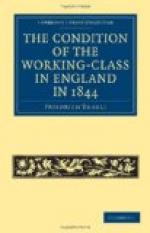“In this and the adjoining district there exists a multitude of foul courts and alleys; many cellars receive all their light through the door, while in not a few the inhabitants sleep upon the bare floor, though most of them possess bedsteads at least; Nicholson’s Court, for example, contains twenty-eight wretched little rooms with 151 human beings in the greatest want, there being but two bedsteads and two blankets to be found in the whole court.”
The poverty is so great in Dublin, that a single benevolent institution, the Mendicity Association, gives relief to 2,500 persons or one per cent. of the population daily, receiving and feeding them for the day and dismissing them at night.
Dr. Alison describes a similar state of things in Edinburgh, whose superb situation, which has won it the title of the Modern Athens, and whose brilliant aristocratic quarter in the New Town, contrast strongly with the foul wretchedness of the poor in the Old Town. Alison asserts that this extensive quarter is as filthy and horrible as the worst district of Dublin, while the Mendicity Association would have as great a proportion of needy persons to assist in Edinburgh as in the Irish capital. He asserts, indeed, that the poor in Scotland, especially in Edinburgh and Glasgow, are worse off than in any other region of the three kingdoms, and that the poorest are not Irish, but Scotch. The preacher of the Old Church of Edinburgh, Dr. Lee, testified in 1836, before the Commission of Religious Instruction, that:
“He had never before seen such misery as in his parish, where the people were without furniture, without everything, two married couples often sharing one room. In a single day he had visited seven houses in which there was not a bed, in some of them not even a heap of straw. Old people of eighty years sleep on the board floor, nearly all slept in their day-clothes. In one cellar room he found two families from a Scotch country district; soon after their removal to the city two of the children had died, and a third was dying at the time of his visit. Each family had a filthy pile of straw lying in a corner; the cellar sheltered besides the two families a donkey, and was, moreover, so dark that it was impossible to distinguish one person from another by day. Dr. Lee declared that it was enough to make a heart of adamant bleed to see such misery in a country like Scotland.”
In the Edinburgh Medical and Surgical Journal, Dr. Hennan reports a similar state of things. From a Parliamentary Report, {35a} it is evident that in the dwellings of the poor of Edinburgh a want of cleanliness reigns, such as must be expected under these conditions. On the bed-posts chickens roost at night, dogs and horses share the dwellings of human beings, and the natural consequence is a shocking stench, with filth and swarms of vermin. The prevailing construction of Edinburgh favours these




